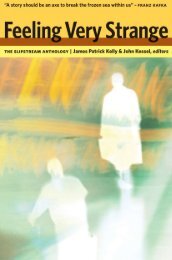The Curse of the Wer.. - Site de Thomas - Free
The Curse of the Wer.. - Site de Thomas - Free
The Curse of the Wer.. - Site de Thomas - Free
Create successful ePaper yourself
Turn your PDF publications into a flip-book with our unique Google optimized e-Paper software.
I USED TO BE A WEREWOLF<br />
his patient Sergei Pankejeff <strong>the</strong> alias <strong>of</strong> ‘Wolf-Man’, Freud was almost<br />
certainly drawing on narratives which juxtaposed <strong>the</strong> contending<br />
<strong>de</strong>mands <strong>of</strong> <strong>the</strong> ‘primitive’ and <strong>the</strong> ‘civilized’ in <strong>the</strong> human personality,<br />
a view that is borne out by his <strong>de</strong>scription <strong>of</strong> ‘<strong>the</strong> contrast between <strong>the</strong><br />
[Wolf-Man’s] agreeable and affable personality, his acute intelligence<br />
and his nice-min<strong>de</strong>dness on <strong>the</strong> one hand, and his completely unbridled<br />
instinctual life on <strong>the</strong> o<strong>the</strong>r’. 8<br />
At <strong>the</strong> very least, <strong>the</strong> name conjured up associations with <strong>the</strong> terrors<br />
<strong>of</strong> folklore and fairy tales, a field Freud was familiar with, through<br />
<strong>the</strong> work <strong>of</strong> Jakob Grimm, Edward Tylor and Andrew Lang. Freud’s<br />
predilection for striking images <strong>de</strong>signed to maximize <strong>the</strong> impact<br />
<strong>of</strong> his work would also suggest that <strong>the</strong> connotations associated with<br />
<strong>the</strong> name he invented for his case history were <strong>de</strong>liberately invoked.<br />
In<strong>de</strong>ed, in his memoirs, <strong>the</strong> Wolf-Man recalled that ‘we happened to<br />
speak <strong>of</strong> Conan Doyle and his creation, Sherlock Holmes. I had thought<br />
Freud would have no use for this type <strong>of</strong> light reading matter, and was<br />
surprised to find that this was not at all <strong>the</strong> case and that Freud had<br />
read this author attentively.’ 9 Certainly, although originally published<br />
un<strong>de</strong>r <strong>the</strong> title ‘From <strong>the</strong> History <strong>of</strong> an Infantile Neurosis’, ‘<strong>The</strong> Case<br />
<strong>of</strong> <strong>the</strong> Wolf-Man’, as it came to be known, could also have worked as<br />
<strong>the</strong> title for a werewolf mystery (and in<strong>de</strong>ed, Algernon Blackwood had<br />
already pre-empted <strong>the</strong> convergence <strong>of</strong> psychoanalysis and lycanthropy<br />
in his 1908 story ‘<strong>The</strong> Camp <strong>of</strong> <strong>the</strong> Dog’).<br />
Even so, Freud did not ostensibly intend to imply that his patient<br />
was lycanthropic. <strong>The</strong> Wolf-Man never imagined himself to be, nor<br />
did he behave like, a wolf. Ra<strong>the</strong>r, <strong>the</strong> Wolf-Man had experienced a<br />
dream as a child, in which his window opened <strong>of</strong> its own accord and<br />
he saw ‘six or seven’ wolves in a walnut tree outsi<strong>de</strong> staring fixedly at<br />
him. He contextualized this dream for Freud as being connected with<br />
his childhood fear <strong>of</strong> animals, particularly wolves. His ol<strong>de</strong>r sister had<br />
fuelled his phobia, taking particular <strong>de</strong>light in tormenting him with<br />
a picture from a children’s story book which <strong>de</strong>picted a wolf standing<br />
upright on its hind legs, stretching out a vicious paw.<br />
Carlo Ginzburg argues that <strong>the</strong> Wolf-Man’s dream none<strong>the</strong>less<br />
contained elements that betrayed an awareness <strong>of</strong> lycanthropy on <strong>the</strong><br />
67





